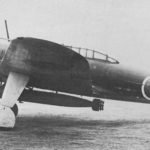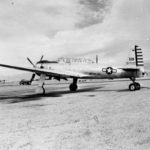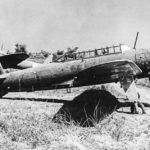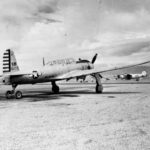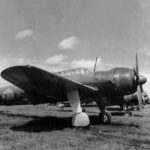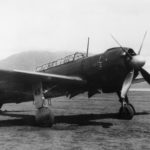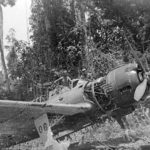Prototype B6N2 Tenzan with torpedo Type 91 mod 4 and radar Type 3
B6N2 Tenzan S19 of Technical Air Intelligence Unit
Captured B6N2 model 12 TAIC S19
B6N2 “Jill” frontal view 3
Wreck of B6N Clark Field 1945
B6N2 Tenzan S19 of Technical Air Intelligence Unit 2
Yagi Type 3 antenna on B6N2, Clark Field March 1945
B6N2 Tenzan “Jill” with air-to-surface radar, Atsugi 1945
Wreck of the B6N “Jill”
B6N “Jill” 31-364
B6N2 Tenzan 48
Captured B6N2 9
B6N2 Jill 06 Philippines 1945
Nakajima B6N1 Saipan 1944
Wreck of B6N
B6N2 Tenzan in flight
Captured Nakajima B6N2 model 12
B6N2 08 equipped with 3-Shiki Type 3 air-to-surface radar
B6N burning after attack on USS Yorktown during Truk Raid 1944
Nakajima B6N Tenzan taking off from an aircraft carrier 1944
B6N Tenzan (Jill) was the Imperial Japanese Navy’s standard torpedo bomber for the final years of World War II. It was a development of the Nakajima B5N and replaced that aircraft in service. Although a highly-effective torpedo bomber, by the time it reached service, the US Navy had already achieved air superiority over the Pacific, and the type never really had the opportunity to display its full potential.
The B5N’s weaknesses had shown themselves early in the Sino-Japanese War and as well as updating that aircraft, the Navy began seeking a replacement. In 1939, it issued a specification to Nakajima for an aircraft that could carry the same weapons load as the B5N but do it faster and over a longer range. The design was restricted by the fact that it also had to fit into the flight-deck elevators of existing aircraft carriers – which the B5N already almost filled. This latter restriction resulted in the characteristic shape of the B6N’s tail fin with its forward-sloping rudder.
Unlike its predecessor, development was long and fraught with problems, including serious instability shown by the prototypes after flight testing began in early 1941, engine problems, and problems associated with carrier take-offs and landings. Rectifying these issues would mean that two years would pass before the aircraft was finally ready for squadron service. Even then, the aircraft’s weight meant that it could only operate from the largest carriers in the fleet.
The B6N1’s combat debut was nothing short of disastrous. The Battle of the Philippine Sea had them operating in an environment where the US had such air superiority that they failed to inflict any significant damage whatsoever, whilst taking massive losses from the US Navy’s new F6F Hellcat fighter. Following this debacle, the Navy ordered several changes to the design, most notably a new engine, resulting in the B6N2.
By this point, small improvements in the B6N’s performance were amongst the least of the Japanese Navy’s problems. When the new model became available in mid 1944, it had already lost most of its large carriers, and was becoming desperately short of experienced pilots. The vast majority of B6N2 operations therefore took place from land bases, and failed to achieve any major successes. They were extensively used in the Battle of Okinawa, where they were also used for kamikaze missions for the first time.
With the Navy’s priorities now shifting to the impending defence of the home islands, a final version of the aircraft was produced for land-only use, sacrificing its carrier operations features in exchange for a little more performance due to weight savings. Two B6N3 prototypes were completed, but Japan surrendered before this variant could be put into production.
A total of 1,268 B6Ns were completed, almost all of them B6N2s. Today, only one remains, preserved at the National Air and Space Museum in Washington, DC.
